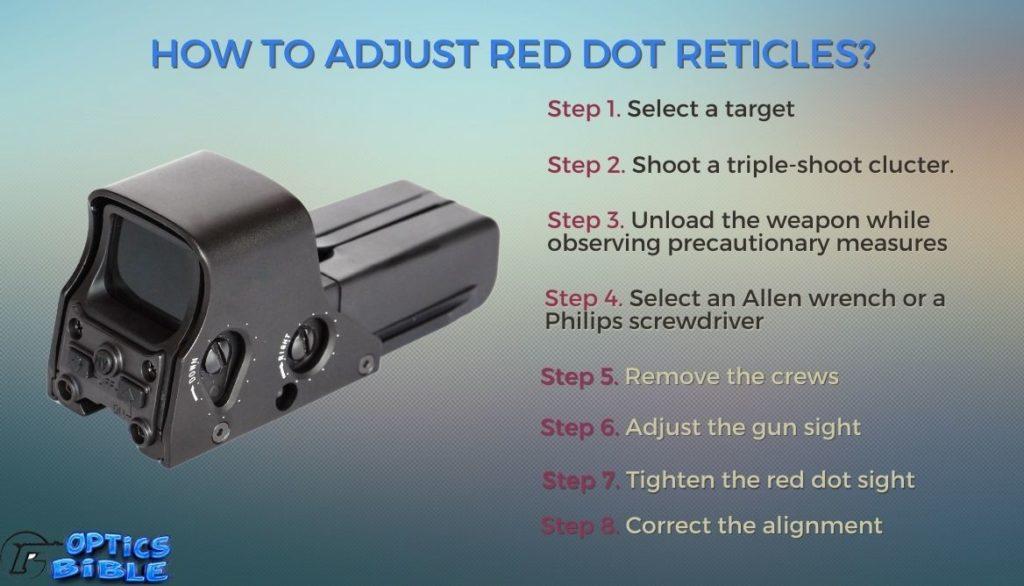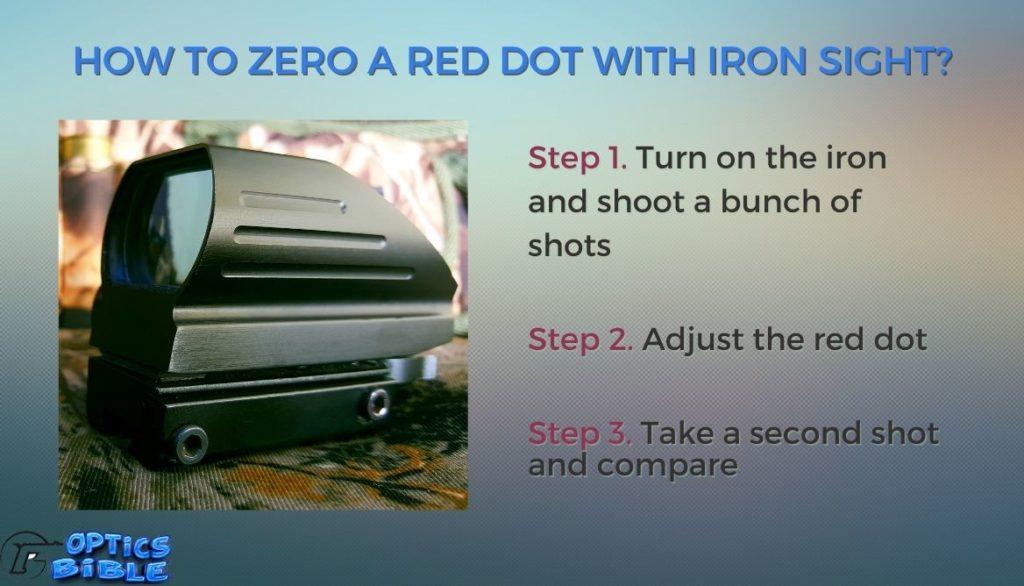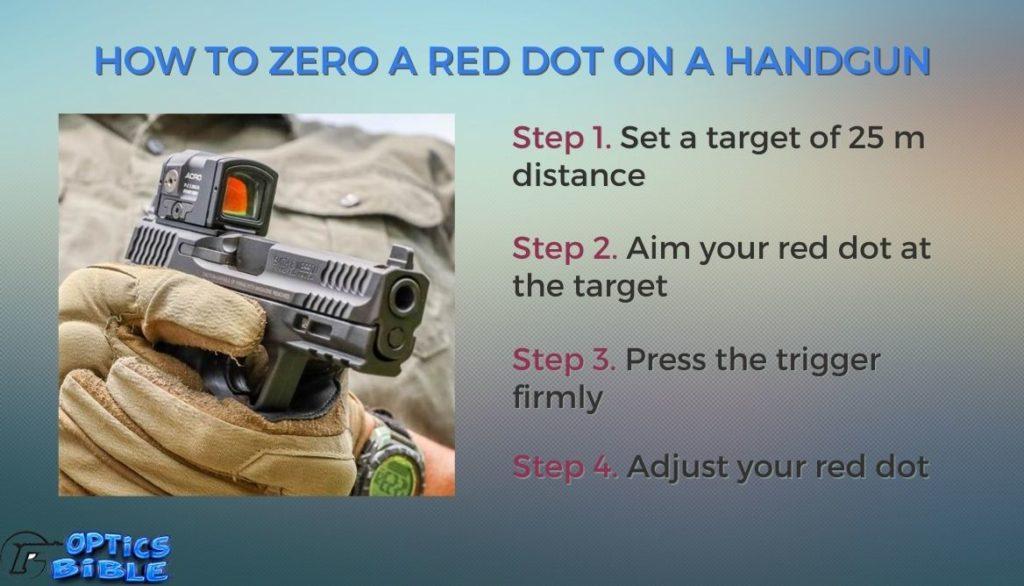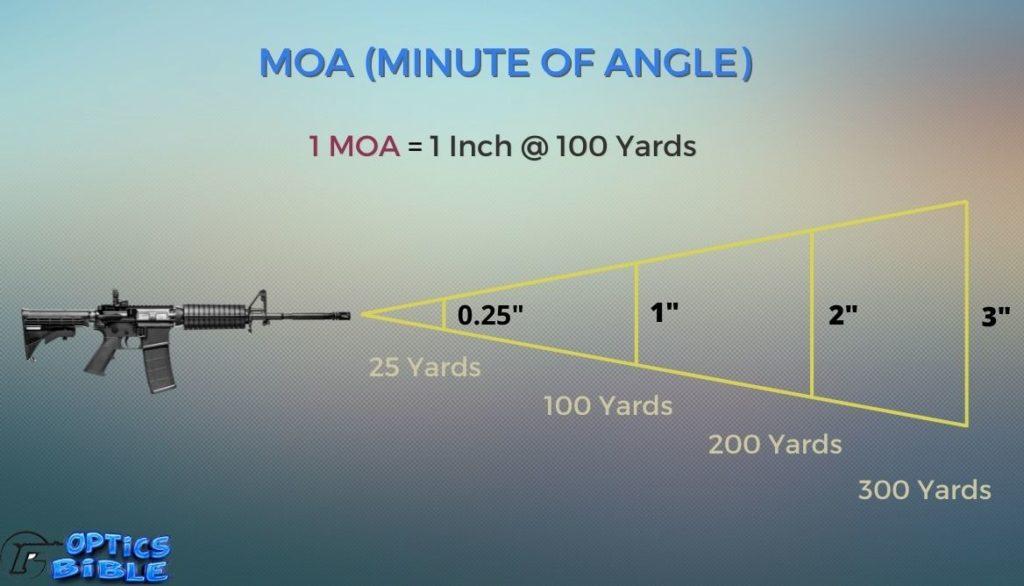How to Zero a Red Dot Sight: Step-by-Step Guide

The red dot sight is the most common optic device used by firearm owners. They offer a clear, expansive field of vision and are parallax error-free. In order to maximize the accuracy of your new red dot, you must zero it so that your point of impact coincides with your point of aim.
To achieve maximum accuracy out of your new red dot sight, you must learn how to Zero your red dot so that your desired point of impact coincides with your point of aim. This post will offer you a comprehensive guide on how to Zero a Red dot in any rifle.
How Do You Adjust Red Dot Reticles?

Step 1: Select a shooting sight
Pick a target on a straight line approximately 100 yards away.
Step 2: Shoot a triple-shot cluster.
to help you determine your point of impact. this will enable the elevation and windage adjustment of your sight to be easily carried out.
Step 3: Unload the weapon while observing precautionary measures.
to reduce the risk of mishaps. Take out every single piece of ammunition from the weapon. Then turn on the safety switch on the weapon.
Step 4: Select an Allen wrench or a Philips screwdriver.
To make adjustments on the red dot sight, you may need an Allen wrench or a Philips screwdriver.
Step 5: Remove the screws.
Step 6: Adjust the gun sight to your preferences.
But ensure you consider your comfort.
Step 7: Tighten the red dot sight.
Correctly to ensure it does not slip out of position during the recoil. this may force the loose gun sight to drift further away from the intended target.
Step 8: Correct the alignment and, if necessary, make additional modifications.
After adjusting the sight, take a practice run to see how it works for you. To get your red dot sight on the rail, take your time adjusting it if you find it needs more tweaking.
What is the Best Distance to Zero a Red Dot?
25 yards is the most effective distance to zero.
When shooting at a fixed distance, the Point Of action (POA) and Point of impact(POI) will match exactly without the need for quick adjustments.
Your rounds will typically land 1.5 to 2.5 inches high at 100 yards.
The difference between P.O.A and POI at 200 yards will be less than 1 inch. This is ideal for close-range shooting and self-defense.
Methods of How to Zero Red Dot Sights

There are several methods for zeroing your red dot sight; we’ve chosen the most efficient method of zeroing your red dot sight.
Bore Sight Spot Checking
Bore sighting is the process of matching a regular rifle sighting to a mounted scope sighting. This will enable your rifle to be accurately sighted in.
The main advantage of bore sighting a red dot is, it saves ammunition, time-saving, and cost.
There are 2 main ways to bore sight. using the Naked eye or the laser boresight
Laser Bore Sight
This method uses a laser module permanently secured in a laser boresight. It centers the user’s aim with a laser pointer, which is especially useful at night.
It also employs the standard red dot as a laser dot pointer marker.
All you need to do is aim at the target after inserting the laser bore sighter into the bore.
How to Zero a Red Dot with Iron Sights?
The use of co-witnessing using iron sights is an additional quick and efficient method of the red-dot sighting.
This can be achieved in 3 steps.
Step 1: Turn on the iron and shoot a bunch of shots.
This will determine whether the iron handgun sights are on target.
When the irons consistently group together, it indicates that they are on target.
Step 2: Adjust the red dot
Adjust the red dot to fit the confirmed distance.
Place the red dot halfway up the front notch and align your front and rear posts when using this arrangement.
Step 3: Take a second shot and compare
The Traditional Way of Bore Sighting
This method of rifle bore sighting enables you to sight your rifle without using a laser bore-sighter, or other tools.
It is incredibly easy to carry out this procedure. However, you require a bolt action rifle with a detachable bolt.
- Remove the bolt From the gun
- Place the gun on a fixed rest (e.g. table with sandbags).
- Aim the bore at a target while keeping your gaze downward (e.g. target a black bullseye).
- Orient the sights to the same target.
- Make that the bore and sights are pointed simultaneously at the same target.
- Fire a few rounds and then adjust the sight system.
You can check out how to do that.
How to Zero a Red Dot on a Handgun/Pistol

A bench with a rest, a small screwdriver, a marker or pen (to mark your hits on target), defensive ammunition, eye, and ear protection, and a laser bore sight are the required items.
This can be accomplished by following these steps.
Step 1: Set a target at a distance of 25 meters.
Step 2: Place your handgun on the stable bench rest and aim your red dot at the target.
Step 3: To fire one round downrange, press the trigger firmly.
Step 4: At this point, adjust your red dot based on the final position of your shot.
Use the elevation and windage knobs to improve your shots.
Making Adjustments on the Red Dot scope to Achieve Zero:
Before making adjustments to the red dot sights, it is important to understand what is the MOA (Minute of Angle).
What MOA?

Minute of Angle (MOA) is an angular measurement whose height (or width) increases with increasing distance.
With MOA, you can adjust for almost any distance without wasting ammunition and express accuracy at any distance.
How to Determine MOA
Distance between two points of impact (inches) divided by [distance in yards / 100] = MOA (accuracy).
MOA (To zero or match POA and POI) = Distance between the point of impact and point of aim (inches) divided by [Distance in yards / 100]
Adjust your red dot’s reticle.
Knowing how to adjust a red dot sight, enables you to shoot as accurately and to take advantage of the red dots sight’ faster target acquisition.
If not lined up, your red dot needs to be readjusted. Adjust the elevation and windage until it sits directly on top of the sight post.
If necessary, the reticle’s brightness setting can also be adjusted.
Which direction do I adjust my turrets?
Turrets are used to change the reticle’s position. Many scopes have three turrets:
- one for focus
- one for elevation and distance adjustment (up/down)
- one for windage adjustment (left/right)
The focus turret is used to achieve clarity while the elevation and windage turrets are only used to zero.
To find out how many clicks on each turret equal one MOA or MRAD, consult the instruction manual that came with your scope.
Most MOA turrets adjust by 1/4-MOA, which means that each click shifts the point of impact by 0.25 “100 yards away. The majority of MRAD turrets use 0.1-MRAD adjustment “100 meters away.
Move the adjustment turrets or buttons on your reticle in the direction you want your point of impact to move. Accordingly, you should move the up/down (elevation) adjustment up if you’re aiming low. Move your left/right (windage) adjustment to the left if your rounds are hitting the target to the right.
FAQ
Why Prefer AR Platforms to Zero a Red Dot?
All AR platforms have the same Picatinny rail, thus enabling easy mounting.
A Picatinny rail is a rail interface system that is used by the military to provide a mounting platform for firearm accessories. It was designed to hold scopes the top of the receivers of larger caliber rifles.
Furthermore, most red-dots mounts are compatible with Picatinny rails.
How to Save Ammo Zeroing
How can zeroing be made simple? You can do that in the following manner:
Use a Zeroing Target
Even if your bore sight brings your aim dangerously close to impact, double-check your zero at a known distance.
Get some Sighting Targets to help you zero at the range with live ammunition.
The targets are pre-printed with perfect 1-inch squares, making MOA adjustments at well-known distances like 25, 50, or 100 yards easy.
It is not necessary to use a spotter scope. Simply count the blocks that exist between your point of impact and the center of the target to determine your difference in inches.
Using a Laser bore sight
You’ll save tons of ammunition if you invest in a good laser bore sight. With the help of the bore sight, you can easily read an estimate of the location of a live round relative to your point of aim on the target. Without ever having to pull the trigger, you can then quickly adjust your reticle and become accustomed to your adjustment knobs or buttons.
Within 50 yards, a bore sight can get you to a nearly perfect zero with only minor adjustments needed, and you can probably get to a full zero at 25 yards.
Can I zero other optics with these instructions?
Yes. The same fundamental adjustment principle applies to red dot scopes, iron sights, and variable or fixed-power rifle scopes: shifting the point of impact by adjusting the point of aim using windage and elevation adjustments
Variable-power scopes, however, need a little more consideration when zeroing.
How can I calculate the number of clicks I need to adjust my reticle?
Multiply The observed difference between your actual point of aim and impact in MOA.
Proceed to then Multiply the Minute Of Angle per click indicated on your buttons or turrets by that number (calculated from above). If it isn’t listed, consult your optic’s manual.
For instance, if your turrets specify “half an MOA” or “0.5 MOA” per click and you observe a 40 MOA adjustment is necessary, multiply 40 by 0.5. this brings you 20 clicks.
What if my red dot uses MILs instead of MOA?
The metric system’s version of MOA is called a MIL. An MOA is equal to 1 inch at 100 yards, while a MIL is equal to 1 centimeter at 100 meters.
If you use the MOL, simply measure the distance between the aim and impact in centimeters instead of inches.
If your red dot uses MILs, convert your aim-to-impact difference from inches to centimeters.
Determine how many MILS per click your reticle requires to adjust, and zero at a known distance in meters rather than yards.
What is the Best Distance to Zero a Red Dot?
This depends on your preference. Some shooters are comfortable at 100 yards while others are comfortable at 50 or even 25 yards. You can try at all distances and choose whatever suits you the best.
However, 25 yards is an ideal distance to achieve that since it helps you prevent any mechanical offset.
The mechanical offset is the distance between the barrel’s center line and the optic attached above it.
How accurate is bore sighting a red dot?
Laser bore sighters are far more accurate than iron sighters, which still rely heavily on the human line of sight.
This is primarily due to the red dot, which is visible even in the dark.
It means you will definitely be able to see your target under the cover of darkness.
Conclusion
Knowing how to zero a red dot will help you achieve accuracy when using a rifle. Luckily now you have a basic understanding of why it’s important to zero your rifle scope and how you can achieve that. If you know any other tricks to zero a red dot, write in the comments. Share with me your opinion on how this article was useful for you.
